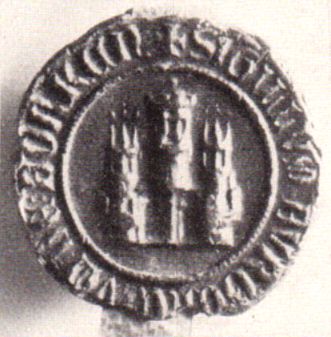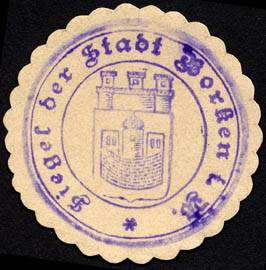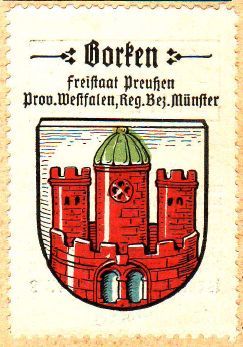Borken (Nordrhein-Westfalen): Difference between revisions
Knorrepoes (talk | contribs) No edit summary |
Knorrepoes (talk | contribs) m (Text replacement - "===Official blazon=== *(de) " to "{| class="wikitable" |+Official blazon |- |'''German''' | ") |
||
| Line 9: | Line 9: | ||
[[File:Borkenn.jpg|center|Wappen von {{PAGENAME}}]] | [[File:Borkenn.jpg|center|Wappen von {{PAGENAME}}]] | ||
= | {| class="wikitable" | ||
|+Official blazon | |||
|- | |||
|'''German''' | |||
| | |||
In Silber eine rote Befestigung mit doppelter silberner Toröffnung in zinnengekrönter Mauer und drei Türmen, von denen der mittlere eine silberne Fensterrose in Form eines Vierpasses zeigt und mit einer in einen Knopf auslaufenden Kuppel bedeckt ist, während die beiden seitlichen einen Zinnenkranz tragen | |||
===Origin/meaning=== | ===Origin/meaning=== | ||
Revision as of 07:39, 5 July 2022
This page is part of the German heraldry portal Deutsche Wappensammlung |
Heraldry of the World |
|
German heraldry:
|
Selected collector's items from Germany:
|
BORKEN
State : Nordrhein-Westfalen
District (Kreis) : Borken
Additions : 1969 Amt Gemen-Weseke, Amt Marbeck-Raesfeld (partly), Borkenwirthe, Gemen, Grütlohn, Hoxfeld, Hovesath, Kirchspiel Gemen, Marbeck, Rhedebrügge, Weseke, Westenborken
| German |
In Silber eine rote Befestigung mit doppelter silberner Toröffnung in zinnengekrönter Mauer und drei Türmen, von denen der mittlere eine silberne Fensterrose in Form eines Vierpasses zeigt und mit einer in einen Knopf auslaufenden Kuppel bedeckt ist, während die beiden seitlichen einen Zinnenkranz tragen Origin/meaningThe arms of Borken were granted on June 24, 1910 and again on April 22, 1970. The arms are based on the oldest known seal of Borken, dating from 1250. Later seals show the same compostion, as is seen on the example below. In the 16th century a small letter B is added to the castle, probably to distinguish the seal from similar seals of other cities. The city wall was added in the 17th century.The castle is a common symbol used in the Middle Ages by cities on their seals, but for Borken it is also a canting symbol; the name is derived from Burke, or castle. The colours are historical and have been used for centuries, their original meaning is no longer known.
Contact and SupportPartners: Your logo here ?
© since 1995, Heraldry of the World, Ralf Hartemink Literature : Stadler, 1964-1971, 8 volumes; Hupp, O: Kaffee Hag albums, 1920s; Meijer, 1940 |

















